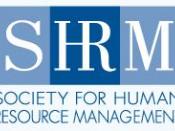The Society for Human Resource Management (SHRM)
The Society for Human Resource Management (SHRM) is the world's largest human resource management association. The Society serves "the needs of HR professionals and advances the interests of the HR profession" (SHRM, 2011, para. 1). SHRM is a valued resource for those with human resources and shared services. SHRM provides information and leadership for human resource professionals. The issue SHRM found was that companies needed metrics that measured the effectiveness of the Human Resource function. SHRM responded to this issue by recommending metrics through its human capital analytics that drive business results. These metrics are also provided to its members through their HR Magazine, surveys, research reports, web casts, white papers, case studies, and access to its outstanding knowledge center (SHRM, 2011). SHRM has also measured the effectiveness of the Human Resource function through its 2009 Human Capital Benchmarking Study, which collected data from over 1,200 organizations in 26 industries.
The key metrics and data collected included human resource departments and expenses, employment, compensation, organizational data including revenue and net income. The study also includes tuition/education data and expectations for change in 2009, (SHRM Study, 2010, p. 2). According to Jac Fitz-enz, Ph. D. CEO, Human Capitol Source, "SHRM has the largest human capital benchmarking database in the world." The outcomes of the company's response to the issue has helped companies through benchmarking, a necessary tool for measuring processes, practices and results against competitors or companies in a similar industry. Some of the results of this study indicated that the human resource expense per full time employee (FTE) declined to a median of $1,063 in 2008, compared with $1,176 in the previous year, (SHRM Study, 2010, p. 6). Other key metrics include HR-to-employee ratios, salaries as percentage of operating expense, target bonus percentage...


